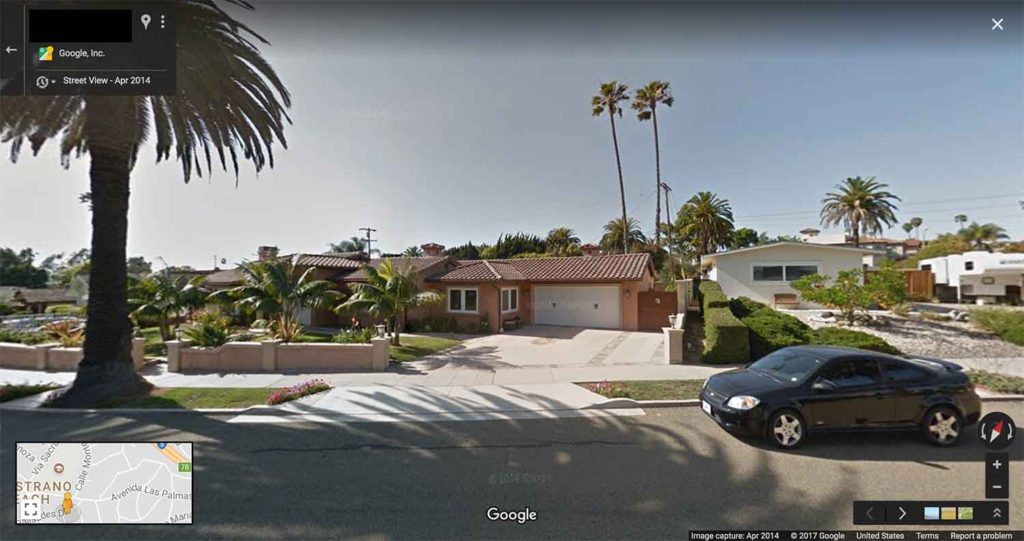If you are involved in the real estate industry in any way, you probably have seen or heard about them by now.
They provide a quick property value estimate without the hefty price tag.
Homeowners, brokers, lenders, developers, and investors all use them.
What am I talking about? Desktop appraisals.
What is a desktop appraisal?
The name pretty much gives it away. If you separate the two words, you get “desktop” and “appraisal.” You can see where I’m going with this.
A desktop appraisal is an appraisal that is completed without the appraiser ever having left their desk. There’s no interior inspection, no exterior inspection, and no measuring. The entire appraisal is completed from the desk.
Desktop appraisals use the data available to the appraiser via third-party resources.
MLS, Public Records, and Google Maps are the main three that come to mind, but there are plenty more resources out there.
Websites like ZoningPoint.com can help you find zoning information, and most municipalities have an eTrakit portal where you can find building permits to see if any work has been done on a property.
Only a licensed or certified appraiser can perform a desktop appraisal. They are not the same as CMA’s (Comparative Market Analysis), AVMs (Automated valuation models), or BPOs (Broker price opinions).
Desktop appraisals are full appraisal reports completed by a real estate appraiser and they can be used for many purposes.
Desktop appraisal vs desktop valuation
You may wonder about the difference between a desktop appraisal and a desktop valuation.
You may have heard both terms because they are often used interchangeably. They are essentially the same thing.
A desktop valuation refers to the process of performing a desktop appraisal. A desktop appraisal refers to the appraisal itself.
The two terms can be used in place of one another, but I prefer to call the appraisal an appraisal and the process a valuation.
Desktop appraisal vs full appraisal
Now that you know the basics, let’s compare desktop and full appraisals.
But without getting too in-depth quite yet, I’ll simplify it first.
A desktop appraisal is the same as a full appraisal but without inspection.
Now let’s go a little deeper.
Desktop appraisals are appraisals that are completed without a physical inspection. This means no measuring, photos, or evaluation is done in person.
The same property analysis occurs in the report, but the data comes from third-party sources instead of a personal property inspection.
As you might be able to conclude, this can result in a lack of accuracy for many properties.
Inaccuracy with this type of appraisal might involve properties with:
- Insufficient data online
- Incorrect data online
- Complex or hidden attributes that aren’t visible on Google Maps or are not mentioned in third-party resources.
- Lack of similar comparables
With that being said, these appraisals can work especially well with other properties.
These may include houses:
- In tract neighborhoods
- In average condition with no recent upgrades
- That has plenty of data available online
- With plenty of comparables
- That have recently sold
In summary, desktop appraisals work great with “cookie-cutter” homes in planned developments but not with unique properties.
Here is an example of a property that a desktop appraisal would not work well with:

As you can see, this property is extremely unique.
An appraiser would most likely have a hard time finding good comparable properties and would need to see this property in person to assess the condition/quality and many complexities.
Here is an example of properties that a desktop appraisal would work well with:

As you can see, this is a neighborhood of similar-style homes that all appear similar in condition/quality and appeal.
This is most likely a tract neighborhood where the houses were built around the same time with similar materials. Most likely, they are all similar in size and lot size.
This is a much better candidate for a desktop appraisal.
Now that you know when and not to use a desktop appraisal, let’s compare them to a full appraisal.
A full appraisal is very similar in that it involves the same research and comparable selection.
However, a full appraisal has the added benefit of an in-person inspection of the property. A desktop appraisal does not.
The inspection allows the appraiser to see the property in real-time, and gather primary data.
It allows the appraiser to get an accurate feel as to the current condition/quality, and it allows the appraiser to see any complexities that the property might have.
A physical inspection of the property allows an appraiser to see the property for what it truly is.
Without inspecting a property, you may miss major deferred maintenance or expensive upgrades not noted on third-party resources.
Online data may not show the property has a pool or a 1,000-square-foot addition in the rear.
An in-person inspection will reveal that.
Third-party data can be useful in many situations but can also be severely lacking in others.
That’s where the difference between a full and desktop appraisal comes to play.
Accuracy
Accuracy is the primary concern when comparing a desktop appraisal to a full one.
Don’t get me wrong; a desktop appraisal can be close to as accurate as a full appraisal if enough data is available.
But, if the data isn’t available or lacking, the appraiser might as well be pulling a number out of thin air.
This is why traditional lenders have not used desktop appraisals in the past.
That said, as technology improves and data becomes more and more prevalent, this will begin to change.
There are hundreds of sites out there that house real estate data.
Sites like Zillow pull all their information from accurate MLS listings, so you don’t need access to the local MLS.
Public record data is available online.
The entire property can be measured on Google Maps.
Google Street View allows an appraiser to see the property from the street. Google Maps even has a 3D option to “fly” around the property as if you were a drone.

With the constant release of new data sources, accuracy becomes less and less of an issue.
And with the availability of new data, desktop appraisals have become more and more popular.
Benefits
The benefits might not be apparent when comparing a desktop to a full appraisal. But they have their perks.
Desktop appraisals best serve as a way to get a quick value estimate.
They are much cheaper than a full appraisal, and the turnaround time is much quicker.
A desktop appraisal’s price and turnaround time can be as low as half a full appraisal.
For this reason, investors and private lenders love desktop appraisals.
Anyone that needs a quick value on a property should consider a desktop appraisal over a full one.
Drawbacks
If there are benefits, there also have to be drawbacks.
Accuracy is the main drawback when it comes to desktop appraisals.
The property is never inspected by the appraiser, so desktop appraisals will never be as accurate.
This means that many assumptions about the property must be made.
While this might not matter as much for some intended users, others might shy away for this reason.
Desktop Appraisal Fee
Desktop appraisals are arguably the cheapest option when it comes to appraisal services.
Depending on the market, the appraisal fee can be a fraction of the cost of a full appraisal.
It is really up to the appraiser when it comes to fees, and every market is different so no specific dollar amount will be given in this article.
Depending on the property, you can typically expect to see the range of fees anywhere from $200+, while a full appraisal will run you $400+.
Which one is right for you?
It all depends on the intended use of the appraisal and the intended user.
If you want to refinance your property through a bank, a desktop appraisal won’t fly.
But, if you are an investor looking for a quick value, and the data is there, then a desktop appraisal might be sufficient.
Conclusion
As you can see, desktop appraisals are a great way to see what your property is worth if you only need a quick value.
They are cheap, fast to complete, and can be nearly as accurate as a full appraisal if available data is available.
While they will never stand up to a full appraisal, desktop appraisals are here to stay.
In fact, they are only becoming more popular as companies accept how much data is available.
2023 Update
This article was originally written a few years ago, and much has changed.
The COVID-19 pandemic led to a fast approval in the usage of various new appraisals by Fannie Mae and Freddie Mac.
Homeowners didn’t want people coming into their homes, so lenders had to develop a way to keep the mortgage industry alive. This led to the temporary approval of COVID exterior and COVID desktop appraisals.
These COVID appraisals essentially allowed the homeowners to collect the data for the appraisal while the appraiser either wrote the report as a desktop appraisal with no inspection or an exterior appraisal with a drive-by inspection.
While these temporary approvals were lifted in early 2020 when the pandemic began to slow down, they had a lasting effect on the industry.
Hybrid appraisals are beginning to gain traction with many large lenders. On March 19, 2022, Fannie Mae and Freddie Mac began accepting desktop appraisals for purchases of one-unit properties with certain guidelines.
As you can imagine, appraisers’ opinions across the county are mixed on these new implementations, but that is a topic for another discussion.
How do you feel about desktop appraisals and the new implementations? Let me know in the comments below.
A desktop is an appraisal without an inspection. Desktop appraisals have to be completed by a licensed real estate appraiser.
Typically desktop appraisals are cheaper. They can be half the cost of a standard appraisal or more.
A desktop appraisal should only take a day or two, depending on the appraiser’s schedule. Because there is no inspection, the appraiser never has to leave their desk. This eliminates the time needed to schedule an appointment and do an inspection.
A desktop appraisal has no inspection. A full appraisal has an exterior and interior inspection or an exterior-only inspection. For a desktop appraisal, the appraiser has to rely on third-party data, which can lead to inaccuracies in the report. Desktop appraisals are usually cheaper and faster than a full appraisal.



Thank you for this information, very helpful. The only thing missing is the date of this article as I would like to know when it was written in to make a judgment on whether anything has changed in the market since it was written.
It was first written in 2019, but nothing has changed since then.
I agree. thank you for the simplicity
What’s your feedback on the latest requirement Fannie and Freddie are going to apply March 2022 in this regard?
It was bound to happen eventually. COVID definitely helped expedite the acceptance. Most appraisers are completely against it, but if there is sufficient data, then I don’t see a problem with them. Appraisers can’t fight progress and technology forever.
Are mls photos needed for the comparable sales. Or no photos at all ok?
According to USPAP, no, but it’s always nice to have so the client can visualize the comparable properties in relation to the subject property.
When the data available is more than 6 months old the desk top appraisal for home purchase is not good. The Real Estate market can change dramatically in a short time. Years old comps done fly!
You’re correct about this current moment in time, but when the market is stable, then 6 month – 1 year comps are acceptable. Also, if there are no recent comparables, then you have to go back in time to find similar ones. It’s better to find similar older comps in the same neighborhood then newer comps in outside neighborhoods.
How is it that whenever there is an article about Desktop Appraisals there is no mention of what appraisers are paid or will accept as customary and reasonable? Thank you
Because that is up to you to decide based on your market. Desktop Appraisal fees will definitely be less than a standard 1004 or 2055, but they shouldn’t be so low that they aren’t worth your time.
do you think one can charge them 600 for a desktop appraisal ? if not then what are some ways
Do you really think that a Desktop Appraiser can charge upto 600 ?
Sure, if there is a demand. I have received that fee and higher
Like in earlier years it will be the appraiser’s fault when the banks and investors loose money!
The appraiser is always at fault 😒
Does anyone realize that the assumptions noted in the form indicate a floor plan is included?
Which form are you referring to?
I’m confused as to what information goes in the top section of the Desktop form page 3 – “Subject Perperty Data Collection Method” and “Subject Data Collection Workforce”. Can you please advise?
Hi Michele, which form are you referring to?